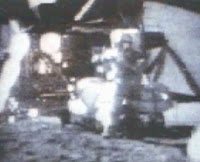Another post deals with the idea of jumping out of the International Space Station. My aim was to give you some ideas to stimulate your learners into thinking about projectile motion, although our curriculum (unfortunately) does not require 2D projectile motion.
Nevertheless, when you address vertical projectile motion, there is a substantial set of interesting facts involved and showing learners a video of the real thing helps a lot (while we are living in the 21st century).
The first video, as far as I know, to show free fall on the moon was the one taken during the Apollo 15 mission that took place from 27 to 31 July 1971. Commander David Scott dropped a hammer and a falcon feather to show that two objects, one heavy and one light, drop at the same rate if there is "no" friction. Although the quality of the video is not good, it was an amazing resource to use in my classes during the early eighties when I started to use it. It is still unique (taken on the moon) and you can download a copy here (size 2,2 MB).
Modern times bring more amazing video material and here is one you can download (21 MB). It shows an amazing facility in which a bowling ball and feathers are dropped in frictionless conditions; this time using high speed cameras to show the action in absolute detail. Compliments to the BBC for making such material to help physics teachers explaining abstract phenomena in our classrooms. Some advice though: Tell learners that the part following from 4:00 minutes deal with Einstein's relativistic motion and they should not mention any of that in their answers as we work with Newtonian mechanics!
While we are busy with issues dealing with gravity, here is a video (145 MB) to show what it looks like inside the International Space Station when a cloth soaked with water is wrung out. The demonstration was based on a question directed to the astronauts and one of them demonstrated it during a video conversation with learners. Look at what happens when something is so called "weightless", what surface tension can do, etc. Amazing visuals!


